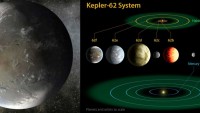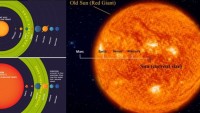Exoplanet Orbiting Three Suns is First to be Imaged from Earth
| Arthur Dominic Villasanta | | Jul 08, 2016 05:06 AM EDT |
(Photo : SPHERE ) SPHERE image of HD 131399Ab
It sounds "Star Wars-sy" but an exoplanet orbiting three suns has been discovered by a team of astronomers led by the University of Arizona. It's the fifth discovery of its kind.
The exoplanet with three sunrises and sunsets is identified as HD 131399Ab. It's got the widest known orbit within a multi-star system yet discovered and is located some 340 light years from Earth in the constellation Centaurus.
Like Us on Facebook
Equally important, it's one of only a few exoplanets that can be directly imaged from the Earth and is the first where an exoplanet orbits three suns. HD 131399Ab is also the first exoplanet discovered by SPHERE, one of the world's most advanced instruments dedicated to discovering exoplanets. SPHERE stands for the "Spectro-Polarimetric High-Contrast Exoplanet Research Instrument."
HD 131399Ab is believed to be some 16 million years old, making it one of the youngest exoplanets discovered to date. Its surface temperature is estimated at 850 Kelvin (1,070 degrees Fahrenheit or 580 degrees Celsius) and it weighs an estimated four Jupiter masses.
Kevin Wagner, a first-year PhD student at UA who discovered HD 131399Ab, said he's delighted "to have seen such a beautiful part of nature that nobody else has seen."
"For about half of the planet's orbit, which lasts 550 Earth-years, three stars are visible in the sky, the fainter two always much closer together, and changing in apparent separation from the brightest star throughout the year," said Wagner.
"For much of the planet's year, the stars appear close together, giving it a familiar night-side and day-side with a unique triple-sunset and sunrise each day. As the planet orbits and the stars grow further apart each day, they reach a point where the setting of one coincides with the rising of the other -- at which point the planet is in near-constant daytime for about one-quarter of its orbit, or roughly 140 Earth-years."
"I think nature will have some other surprises in store for us as we continue exploring," said Wagner.
Tagsexoplanet, three suns, HD 131399Ab, university of arizona, Kevin Wagner
©2015 Chinatopix All rights reserved. Do not reproduce without permission
EDITOR'S PICKS
-

Did the Trump administration just announce plans for a trade war with ‘hostile’ China and Russia?
-

US Senate passes Taiwan travel bill slammed by China
-

As Yan Sihong’s family grieves, here are other Chinese students who went missing abroad. Some have never been found
-

Beijing blasts Western critics who ‘smear China’ with the term sharp power
-

China Envoy Seeks to Defuse Tensions With U.S. as a Trade War Brews
-

Singapore's Deputy PM Provides Bitcoin Vote of Confidence Amid China's Blanket Bans
-

China warns investors over risks in overseas virtual currency trading
-

Chinese government most trustworthy: survey
-

Kashima Antlers On Course For Back-To-Back Titles
MOST POPULAR
LATEST NEWS
Zhou Yongkang: China's Former Security Chief Sentenced to Life in Prison

China's former Chief of the Ministry of Public Security, Zhou Yongkang, has been given a life sentence after he was found guilty of abusing his office, bribery and deliberately ... Full Article
TRENDING STORY

China Pork Prices Expected to Stabilize As The Supplies Recover

Elephone P9000 Smartphone is now on Sale on Amazon India

There's a Big Chance Cliffhangers Won't Still Be Resolved When Grey's Anatomy Season 13 Returns

Supreme Court Ruled on Samsung vs Apple Dispute for Patent Infringement

Microsoft Surface Pro 5 Rumors and Release Date: What is the Latest?













